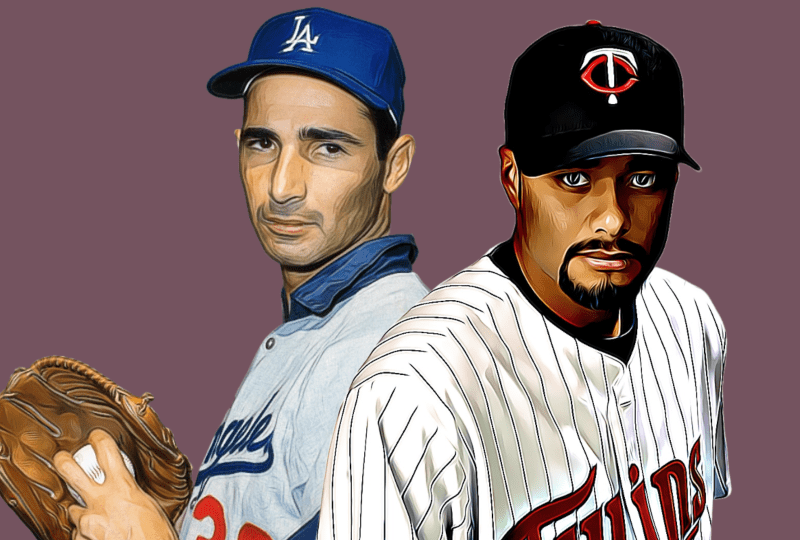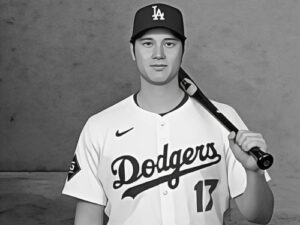If Sandy Koufax is in the Hall of Fame, why isn’t Johan Santana? The answer lies with the two p’s: perception and postseason. Koufax set strikeout records, was a mythical enigma, he was “The Left Arm of God.” Santana was a lefthander from Latin America who pitched in Minnesota, managed just one win in the playoffs, and hurt his arm.
Yet, a solid argument can be made that Santana was a better pitcher than Koufax. Yes, really.
The similarities between Santana and Koufax
First let’s look at the similarities between the two great lefties. Both played unconventional positions as youngsters: Koufax was originally a lefthanded catcher and Santana played shortstop lefthanded. Young Johan wanted to play shortstop so bad that he taught himself to throw right-handed so he could stay there until his early teens. Each pitcher had their first full season in a major league rotation when they were 25 years old.
Both Santana and Koufax had to work things out in the bullpen, and took baby steps to becoming rotation regulars. Both pitchers relied on pinpoint control of their fastball, though Koufax took longer to tame his speed pitch (which was faster than Santana’s by about 6-10 MPH).
Santana and Koufax both had six-year runs that are among the most dominant stretches of pitching since the end of the deadball era.
Koufax won three Cy Youngs during his peak, while Santana won two and finished in the top five four straight years, just like Sandy.
Both pitchers led their league in many categories: Koufax won four strikeout titles and Santana won three; Koufax led the league in ERA five times, Santana three times. Santana and Koufax both led their leagues in innings pitched twice.
Both pitchers helped their team to the postseason four times. Both pitchers threw no-hitters, though Koufax tossed four and Santana one.
The differences between Koufax and Santana
Now for the differences. Koufax pitched in Los Angeles, in the shadow of Hollywood, he was a handsome superstar, a Jewish icon. Santana toiled in Minneapolis, the most midwestern of all midwestern cities, and one of the smallest markets in baseball. He had a halting command of English, he was overshadowed by more famous pitchers on big-market teams.
Koufax threw a 97-101 mile per hour fastball and paired it with the best curveball in the game, a pitch that dropped from twelve to six. Santana’s heater topped out at 95, but his best pitch was his circle change, which acted like his fastball but dipped away from left-handed batters and in on right-handed batters at the last second. It was a devastating weapon.
As for the postseason, Koufax was a beast, he started seven World Series games and only lost three of them because his teammates couldn’t get him many runs or they played poor defense. In his four postseason wins Sandy allowed three earned runs, and in his three losses he allowed three earned runs. His postseason ERA was 0.95 and he fired two shutouts. Santana made five postseason starts and he pitched brilliantly in four of them, allowing three earned runs in 24 innings. But he had one clunker in 2003 when he surrendered six earned in less than four innings. His postseason ERA was a solid 2.93 though he never went as deep as the eighth inning.
The injuries
Both Koufax and Santana had aborted careers because of an injury to their elbow. In the case of Koufax it was chronic arthritis, while Santana tore his shoulder capsule and had bone chips floating around in there. The third and final time Santana ripped his shoulder to bits, it was a career-killer. After the age of 31, Santana never pitched without pain and only made 21 starts. Koufax, of course, never made a start after the age of 30: he walked away from the game rather than risk crippling damage to his arm. It was a formality that Koufax would be ushered into Cooperstown six years after his shocking retirement announcement. But Santana received only ten votes and was one-and-done in his lone appearance on the ballot.
Part of the reason why Santana seems like a lesser pitcher is the way his career unfolded. Santana had three “setup years” where he paid his dues in the bullpen. Then he embarked on his six-year dominance. Then he had three years where he was in pain and pitched unevenly. He tried several comebacks, the most recent in 2016, but all of them failed. In contrast, Sandy Koufax started his career as a teenager and struggled to lasso his gift for six years before embarking on his six-year peak. One month after the 1966 World Series, he abruptly retired, days after winning his third Cy Young award. No one ever made a better exit. Santana’s last impression was his unsuccessful attempts to come back from a damaged left elbow after a very un-Santana-like final season.
| PITCHER | WINS | PCT | ERA+ | K/9 | BB/9 | CY | MVP |
| Koufax (1961-1966) | 129 | .733 | 156 | 9.4 | 2.3 | 3 wins, 4 top 5 | 1 win, 3 top 5 |
| Santana (2003-2008) | 98 | .700 | 156 | 9.4 | 2.1 | 2 wins, 5 top 5 | 2 top 10 |
The discrepancy in wins is accounted for by the difference in usage of starting pitchers in the two eras. Koufax averaged 30 decisions per season during his peak, Santana averaged seven fewer. Give Santana the seven extra decisions each year and his win total would be 128, essentially the same as Sandy’s. It’s not Santana’s fault that his teams only wanted him to go six or seven innings per start. It wasn’t his fault either that the league was 50 percent larger and the competition for awards was more intensified in his era. In a ten-team league, Santana might have won one or two more Cy Young awards.
Koufax pitched about 30 more games and pitched almost exactly 200 more innings than Santana, though they both had 12-year careers. Their numbers are very close. But the perception favors Koufax by a factor of about a million. Outside of a few experts, his fans in Minnesota, and those who cheered his no-hitter for the Mets, Santana has few supporters for the Hall of Fame. But he should, he was the closest thing we’ve had to Sandy Koufax since that golden left arm retired itself more than 50 years ago.






